By Dan Hinchen
This week will be quiet here at the MHS but we still have a couple reasons for you to break your cabin fever and pay us a visit.
First, we are happy to announce the opening of our most recent exhibition, “Proclaim Liberty Throughout All the Land: Boston Abolitionists, 1831-1865.” Through various artifacts, manuscripts, and photographs related to the abolitionist movement, this exhibit demonstrates how Boston emerged as a center for the national antislavery movement in the decades leading up to the Civil War. Included in the display are examples of William Lloyd Garrison’s, the Liberator, the country’s leading abolitionist newspaper, published in Boston beginning in 1831. Also illustrated is the fierce resistance that this radical movement received, not only from Southern slaveholders, but from Northerners, as well.
Complementing this new exhibit are two minor exhibitions that spotlight Abraham Lincoln and the signing of the Emancipation Proclamation, an event that occurred on the first day of the new year exactly 150 years ago. All of these exhibits are free and open to the public with opening hours Monday-Saturday, 10:00am-4:00pm. All three will be on view until 24 May 2013.
On Tuesday, 26 February 2013, join us for another installment in the Immigration and Urban History Seminar series. Starting at 5:15pm, David Jaffee of the Bard Graduate Center will present “Seeing in the City: Broadway and the Culture of Vision in 19th Century New York.” With Keith Morgan of Boston University providing comment, Mr. Jaffee explores Broadway as the central location for various case studies of cultural entrepreneurs and as the subject and site of new ways of seeing in the city. Seminars at the Society are free and open to the public though, RSVP is required. Subscribe to receive advance copies of seminar papers.
Finally, make note that this Saturday there will not be a public building tour as the Society plays host to part one of “Writing, Reading, & Preserving Eighteenth-Century Letters,” a two-part teacher workshop. In this workshop, done in conjunction with the Revere House, teachers will learn about the importance of letters as communication tools in the 18th century and as their importance as historical sources today. For more information about the workshop, please contact the Historical Society’s Education Department at 617-646-0557 or education@masshist.org.
And as always, keep an eye on our calendar for information about upcoming events.



